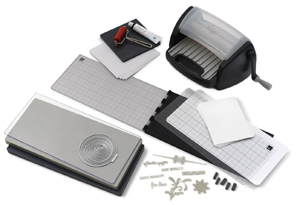
The web has been buzzing lately about the new L Letterpress Tool by Lifestyle Crafts, a division of QuicKutz, best known for their die-cutting tools. I have to admit that I was rather dubious about this new tool. Could what amounts to a piece of plastic really come close to duplicating the effect created by an antique press? However, my curiosity was piqued, and when I saw that Paper Source, who will be carrying the L Letterpress in their stores, was offering demonstrations this weekend I had to go and check it out.
I watched a demo video of the tool before I went to the in-person demonstration, so I had a good idea about how it worked. The tool comes with two main pieces, a heavy plastic hinged piece that serves as a place to layout your design using printing plates — the “plates” look a lot like unmounted acrylic stamps, though I forgot to ask whether acrylic stamps would work in the tool (they may be too thick to properly work) — and to position your paper in preparation for printing. You use special oil based letterpress ink and a brayer, which comes with the L Letterpress kit, to apply ink to your prepared design. After the design has been inked, you fold the hinged piece until the inked plates are in place over the paper, and you run the whole piece through the second part of the tool — QuicKutz’s Epic Six tool, originally one of their die cutting products — which actually does the “letterpressing”. If you’re interested in seeing a demo in action, you can watch this video:
What I was most curious about was what sort of impression this tool made on the paper. I couldn’t really tell in the video I’d watched or any of the pictures that I’d seen of sample products made by the L Letterpress. I was actually pleasantly surprised by the result. It seems to take a bit of practice to get the amount of ink right, but when you do you get a nice inked impression that does look quite like a piece made with an actual letterpress. In the demonstration that I saw, regular cardstock was used, but the woman doing the demonstration mentioned that you could get an even better impression if you used a thicker, cotton based paper like many real letterpress shops use. I wish that I could’ve gotten a sample card or something to bring home with me to photograph, but because the ink used is oil based, it hadn’t dried in time for me to get something.
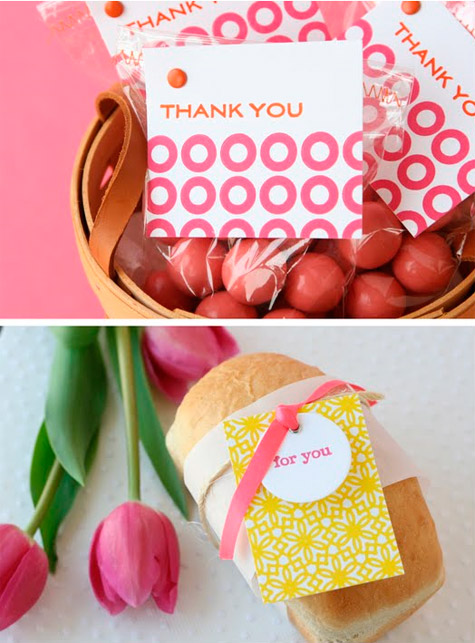
Now, do I think that the L Letterpress tool is going to replace the antique letterpress? Of course not. But this tool has made me ask myself a rather philosophical question: what is letterpress? Is letterpress merely the technique of creating an inked, debossed image on paper, or is it much more than that? I have to admit that there’s something very romantic to me about finding that rare treasure, an antique press, and pouring your efforts into getting it into working condition so you can create beautiful cards, invitations, posters, and other wonderful letterpress goods. But the fact is that a real letterpress isn’t a practical choice for most of us.
The L Letterpress Tool allows those of us who are interested in letterpress technique but who may not have the room to house a 1,000+ lb. machine, the desire to go on what may be a fruitless expedition in search of the increasingly hard to find presses, the money to invest in parts to get the press in working condition again, or the time to do most of the above to actually give it a shot in the comfort of our own homes.
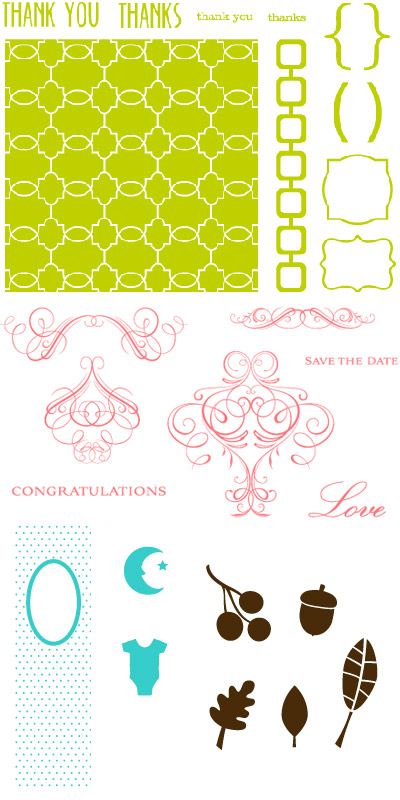
While the tool does make letterpress more accessible to hobbyists and crafters, I also see some limitations with it in its current state. My main concern is flexibility. As of now, Lifestyle Crafts has released several sets of plates for the L Letterpress (examples shown above), and while they’re perfectly nice, variety is limited. I could see myself experimenting with their plates, but after I got the hang of things I know I’d be looking to create my own custom work, and as of now that option isn’t offered. I did ask my Paper Source demonstrator about using photopolymer plates like those used in real letterpress, and she told me that she thought that those would work perfectly fine in the tool. While that has me very excited, I need confirmation that this will work before I make the investment. I’m planning on contacting shops that I know make the photopolymer plates to see if they might be able to confirm that their plates can be used in this machine, and I’ll update you here when I have more information.
Update: I caved and bought an L Letterpress, and thanks to Diane’s tip in the comments about the A.C. Moore coupon, I saved 50%. Pretty great deal! Now that I have the tool, I will be able to test photopolymer plates and will share my results as soon as I have them.
Update #2: I’ve posted my results with the standard plates for the L, as well as preliminary custom photopolymer plate results.
The other main drawback to the L Letterpress, for me, at least, is another that involves lack of flexibility. If you want to create normal sized cards and similar items, then it’s the perfect size, but if you want to expand into larger cards and invitations, or posters and other goods, then the dimensions of this tool are going to be much too small. While this isn’t too big a deal, you’ll want to consider the types of things that you want to make before purchasing the tool.
I did learn a couple of tips about the L Letterpress, thanks to my Paper Source demonstrator, and these might help you if you plan on purchasing. Instead of using the double sided adhesive that you can purchase to adhere the plates to the surface in preparation for printing, used double-sided tape instead. It will save you both money and time. Also, after you attach the tape or adhesive to the plate, instead of trying to guess where you need to place the plate on the hinged lid in order to get the perfect placement on your card, turn the un-inked plate face down on the paper where you want it to be printed, and bring the hinged lid around, pressing down on the adhesive backed plate to make it stick. Ta-da, perfect placement!
As a side note, I learned that the L Letterpress can also serve as a die cutting tool, which makes sense given that the part that does the pressing was originally (and is still) used for creating die cuts. The kit comes with a set of circular dies, but I was told that the dies leave marks on the plastic lid of the tool, and the Paper Source demonstrator told me that they weren’t using the dies until they could figure out how do create die cuts without damaging the plastic lid. Something to think about before you use the tool for die cutting!
In conclusion, I have to say that I like the L Letterpress Tool more than I thought that I would. Letterpress purists may think that it’s the devil, and I can certainly understand where they’re coming from. I’m no purist, but I do love letterpress, and part of that love is about the effort and process involved in setting up an antique letterpress. If someone is a letterpress printer, then you know that they love what they do, and I think that comes through in what they create. I’d actually say that seeing the new tool in action gave me an even deeper appreciation for what letterpress printers do. Will I be purchasing the L Letterpress Tool? If you can, indeed, use custom photopolymer plates in it, then you bet! But I’ll also continue to add to my collection of letterpress lovelies created by my favorite studios. In fact, I picked up a couple of new cards after the Paper Source demo. I can’t step foot in that place without spending at least $50, and I know that won’t change!
Psst … if you want a chance to win an L Letterpress Kit, then check out iDiY! They’re giving away one of the kits, and you can enter to win until November 18, 2009.
images from Lifestyle Crafts





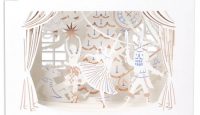
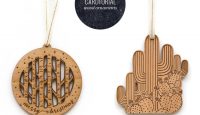
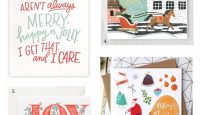

great review, thanks for posting – im really eager to check this out in person… and if they can actually use photopolymer plates!
I wrote a post about this new kit as well after seeing at AC Moore, you can probably use one of AC Moore’s 50% off coupons on this kit since I didn’t see it listed as an exclusion. Something to think about.
I’m not sure how this will impact the letterpress industry. I would feel kind of ripped off if I bought a card if it were created with the L Letterpress kit rather than an antique letterpress machine. It’s a tough call.
50% off would definitely make for a pretty sweet deal. Thanks for the heads up about that!
I have similar concerns as yours, Diane. As a crafter, I can’t help but be excited by the possibilities with this tool, but I wonder if we’ll be seeing lots of cards created using the standard plates in the coming weeks and months on Etsy.
While I’m jazzed about the possibility of being able to use custom photopolymer plates with the tool, it will just make it tougher to discern what’s been created with the L Letterpress and what’s been created with an antique press, especially if you’re making your purchase online. Like you, I can’t help but think that I’d be disappointed if I paid $4+ for a card and found out that it had been created on the new tool. When I purchase letterpress goods, I’m willing to pay the premium because I know what’s involved in creating the card. With the new tool, well, it’s just not the same. I find myself feeling really torn about this.
Great post. I have been looking into this as well (I have a homemade letterpress that is great, but for larger quantities is very tiring to use – it uses a bottle jack to press the plates together), and I thought it looked suspiciously similar to my Accucut Zip E Mate. So, I put my photopolymer plate in the Zip E Mate and voila, inked and debossed! Good tip to know if you already have these tools and don’t want to drop the money on a whole other set. May be worth just buying the hinged piece, I don’t know.
Just like all of you are saying, yes, the art of letterpress may not be the same here, but at least people can try and get a new appreciation for the old art form for a lot less money and space.
I had no idea this device even existed! I’ll have to head to Paper Source or AC Moore to check it out.
It reminds me a lot of the Gocco machine, and I used to have similar feelings about Gocco vs. traditional screen printing. As a screen printer, I used to get frustrated by seeing Gocco’d products sold as “screen prints,” but in general I think people can truly see the difference in quality. And to be completely honest, I’ve had several clients come to me after trying to Gocco invites themselves, only to give up in defeat when they realize they can’t get a perfect print every time. In a way, I think it helps folks understand the level of complexity involved in these traditional printing processes!
awesome review, thank you so much!
I too would only purchase if I could use custom plates. I did not realize it could be used (maybe) for die cuts. If this machine can really be multi-purpose that would definitely increase the chances I would purchase.
I think this idea is awesome however I am put off that you can’t do your own custom designs. I don’t really like working with cookie cut things. I think of it as a gocco though. Nothing can replace the history of the letterplace machine. There is something romantic and real with the old method.
I think ‘letterpress’ really just means printed with relief plates rather than litho or silkscreen. My file dividers are letterpressed, and I bought them at the local stationery store; letterpress doesn’t automatically mean embossed cotton paper and limited runs.
This looks like a great little machine, although limited; thanks for your detailed review!
Sounds like a great tool if you don’t mind using their plates. That would get very old very fast for me.
I’d love to know if you can use your own plates with this though – now that would make it quite worthy.
Looks like it may be woth a try!
Thanks for the detailed review. I’m very interested in this. So the info was quite useful. Nice to know that AC Moore has them too.
noteify – thanks for the info about the Zip E Mate!
Carrie – You’re so right that this tool is to letterpress as Gocco was to screen printing, and I’m so glad that you shared your experiences. If anything, this new machine may help more people understand just what is involved in the process, and when they reach the limit of what they’re able to do or what the machine is able to do, they’ll seek out the pros for custom work.
And I completely agree with what many of you are saying about custom plates. For me, it’s not worth the investment unless custom is possible.
Hi! I have an antique letterpress and do wedding stationery and cards…
An interesting point in the comments above is the willingness to pay higher money on a letterpressed card done on an antique press versus one with this new machine. The prices are higher, not because it was done on the antique press but because the cost for photopolymer plates is pretty high and the time spent printing the cards is substantial. I would think the time spent and the materials costs would be similar and the cards would cost the same. In theory, the results should be the same since letterpress is a printing technique and not really about the equipment itself. BUT, I cannot imagine there would be much of an impression (if one is desired) to be achieved since you need a LOT of weight to do so. Sure, soft paper can help, but it needs hundreds of lbs. of weight to get impression…doesn’t it? I’m not even sure on how much weight. I know my press can cut fingers off if they get in the way. I’d be curious to see this little machine for myself. It seems like a cool idea and I hope it delivers the goods for all the people who want to try this craft for themselves! It’s not easy and it’s time consuming; but the results are always so satisfying!
Hi, Megan! Thanks so much for your input; it’s definitely got me thinking. I guess I always assumed that there was substantial cost involved in refurbishing and maintaining the presses, in addition to costs associated with having the photopolymer plates made and the time spent printing. What you said has caused me look at things in a different light.
I’m so happy you wrote this review. I’ve been wondering about this little machine a lot and I respect your insights. It’s also been great to read people’s comments. I’m looking forward to hearing what you find out about custom plates. I think that will be the true kicker for me too.
I have the best news ever! It is in AC Moore stores right now, along with the plates, ink, everything – AND they have a coupon on their website for 50% off a single item and it totally works for the L combo! That’s a savings of $75!!! I just went to my local store and they took the coupon no problem. To get the coupon just go to AC Moore’s website, click on store locator, type in your zip, find your store, and click on coupons/sales. there is a PDF you can dowload with the coupon! It’s only good until this weekend so hurry up before they change it! (the coupon specifically states it’s not good for things like cricut so I’m sure they didn’t think about this new letterpress when they created the coupons!)
yippee!!!!
Yep, Jen, that’s how I got mine! I think that you’re right about them not considering the tool for the typical coupon exclusions like Cricut, Yudu, etc. But that probably won’t last for long, especially if this tool becomes popular. Thanks for the information!
Great review! I am looking forward to seeing your work on this press and seeing what you find out about the custom plates! The only way I would buy one is if I could make my own art.
I think it’s an interesting machine if you’re looking to do some craft cards and small things like tags, etc. However, with all due respect to the posts and opinions above, real letterpress and it’s cost is not just simply about the price of photopolymer plates. If you are a letterpress printer and that is your livelihood you have overhead, i.e. studio space, material costs, energy costs, equipment costs, perhaps even educational costs (I have a Master’s Degree in Printmaking). In addition, letterpress is not just about placing a plate on a base, inking it, and printing it. It is an art that takes years to really learn and even longer to become proficient at. I can’t imagine that this machine could give results like an 1100 lb. Vandercook or Heidelberg, and while it may satisfy crafters needs, it could hardly be considered a serious letterpress printer’s tool. While understanding that this is probably not the goal for this particular machine, I just want to be sure that people do not confuse true letterpress printing and work from machines like this one.
This is a great review Kristen, thank you so much! I emailed the company last week and they confirmed that photopolymer plates would work with this machine. I am heading to Paper Source this weekend to see it for myself and I can’t wait to hear more about your experience with it.
I completely agree with Bethany. Printing, and particularly real letterpress printing, is an art and a skill set that many fine craftspeople rely on to make a livable wage. Real education, real equipment, real typesetting and platemaking, and real experience cost time and money. I have demo’ed letterpress printing for people who have never seen it done before and I can tell you that once they see the full process for themselves, they no longer think letterpress is expensive. To call this a “home letterpress machine” is laughable. This is a glorified STAMP Quickcuts is trying to justify $150 for by using the term “letterpress” in the name.
Quikcuts can call it whatever they want. I always thought that Sizzix embossing dies could be flipped and have that “letterpress” look. It’s obviously not a 1000 pound letterpress, but for crafters or people who want to play with letterpress, I think it’s going to be fun – and I have one on the way.
Interesting product. I think it’s sort of funny that those who think this is a not a letterpress machine don’t see that this product is very similar if not a consumer friendly version of a galley proof press. Something along the lines of a nolan press. Also since this product is obviously based on the design of a cylinder letterpress… it doesn’t require 1,000 lbs of pressure in order to get the embossed effect. One of the benefits of a cylindar press is that the pressure is concentrated in a very small area specifically where the cylinder meets the paper and the type. The one thing wrong with this press is that there is a plastic cover over the top when you push it through the system…otherwise you would have a galley press. Also I noticed that this little press seems to do large surface areas pretty well… again one of the benefits of a cylinder press. By the way, I own 2 C&P Pilots, 1 Sigwalt, and 1 galley proof press and I learned letterpress using a Vandercook. Anyways, looks pretty cool…might just have to get one to play with.
Alexandra et al are right–this is a good machine for a crafter, but that’s it. “Innovations” like this make me laugh–they’re not a step forward, they’re a step back 500 years. This is like Gutenberg’s press, or an iron handpress, without the platen. And you know what is an improvement on that style of press? ANY other press, including my 100 year old ones. I don’t think this hurts the crafts people who make their living as letterpress printers anymore than camcorders hurt the movie industry; there’s no way to make a living with this machine, that I can see.
I’ve been looking at this machine for a while for personal business cards, etc. – I cannot find it listed on AC Moore’s website. I live in TX so there aren’t any stores around.
A lot of tools like this seem to dumb down the industry and make it easy for anyone to be a ‘designer’. Nothing wrong with that I guess (I am a little bias as a print designer myself), but I like to step back and really appreciate the craftsmanship and skill it takes to run a true letterpress and the results those presses produce.
Thanks for your great review and the comments have all been interesting and helpful. I do wonder if you can use the acrylic stamps in this machine. glad to see that you can use regular cardstock. Also wondering about the ink. Does it have to be oil based and could you use another print making paint that is out there?
Pingback: All Things Metal Clay » Blog Archive » Another use for those Photopolymer Plates
Pingback: L Letterpress Printing Techniques from Boxcar Press at Boxcar Press – Us
Pingback: L Letterpress Review Update with Preliminary Custom Plate Results | paper crave
Pingback: Another use for those Photopolymer Plates | Metal Clay
I just discovered this tool and am heading out to Paper-Source to take a look – probably missed the demo. But I did find that Elum press makes plates specifically for this tool. Take a look http://www.letterpressplates.com/quickutz-l-letterpress/
I’ve seen the demos for this and it looks pretty pathetic — likely to excite scrapbooking types but otherwise quite worthless.
It bears as much resemblance to a real letterpress as a skateboard does to a Porsche.
Pingback: D.I.Y. Letterpress Invitations « The Bohemian Bride
Hi! Thanks so much for your review of this machine. I’m eager to check it out at Paper Source.
How do you feel about it after having used it for 4-5 months?
I’ve noticed that custom made plates are being offered. Have you by chance tried them? http://lifestylecrafts.com/customPlates/
All of these comments are interesting. This product is just responding to demand. People like letterpress. However, it’s just a tool. Just because someone buys the tool, it doesn’t mean they will instantly be able to produce stunning letterpress – it doesn’t instill creativity in the user any more than buying a copy of Adobe Illustrator makes you a great illustrator. You have to have the skill and talent to make use of the tool to create great art. The computer, the letterpress, the pencil – they’re just tools in the hand of the user!
Saw this item discounted at “A Cherry on Top”, watched the video, have questions:
Why can’t you use a stamp pad to ink the printing plate? Can you use an unmounted rubber stamp or a clear stamp instead of the print plate? (I find it SO frustrating to be limited to the images that each machine manufacturer offers!) Will this machine cut/emboss dies from other manufacturers (Sizzix Sizzlets, Big Kicks, Spellbinders, Cuttlebug)?
Any additional info will be appreciated. Feel free to respond directly to my email. sab
I have the same questions as Shirley. I would love to get into embossing (I am a scrapbooker) and dont want to be limited by 1 machine. If this machine can do embossing and letterpress it would be fantastic.
I too wonder if you can use clear stamps in it. I dont think my husband would appreciate me purchasing the presses and the add on for the machine on top of all the other scrapbooking supplies I already own (purely a space issue!)
Any comments would be fantastic.
does anyone know if michaels or ac moore still sell this?
Thank you for your L Letterpress review! It is just what I was looking for. 🙂
If you couldn’t tell the difference between a card made on a home letterpress vs an antique letterpress, how could you feel ripped off?
Also, I can’t find one of these things to buy today (2013) and am wondering if all this could be done on today’s die cutting machines using deeply etched stamps (metal or plastic), pads and the Sizzix, Cuttlebug, BigShot, et al.